Bulletin – December 2019 Financial Stability The Nature of Australian Banks' Offshore Funding
- Download 597KB

Abstract
Australian banks access large and deep foreign funding markets to supplement their domestic funding. Looking at the major banks’ worldwide operations, such offshore funding accounts for about one-third of their assets. This funding is raised in a variety of ways, across several countries and by various entities within the banking groups. While offshore funding can create vulnerabilities, these are appropriately mitigated by various factors. It would nonetheless be desirable for banks to continue to lengthen the maturity of their offshore debt securities.
Background
Large banks source funds from a wide range of countries, in addition to attracting domestic deposits. This enables them to diversify their funding sources, access deeper and more liquid markets and borrow for longer terms than they often can domestically. However, offshore funding can be riskier than domestic funding because it involves more ‘rollover risk’.[1]
Rollover risk is inherent to banking. It arises because a core function of banks is to engage in maturity transformation by borrowing for short terms (including by issuing deposits) and lending for longer terms. In doing so, banks fulfil two critical needs – for borrowers to have certainty about the security of their long-term financing commitments and for savers to have access to liquid assets to manage their cash flow.[2] Nonetheless, the risks involved in such maturity transformation must be adequately managed to prevent banks from failing.
There are two reasons why offshore funding involves more rollover risk than domestic funding. One is that investors tend to reallocate their portfolios away from foreign investments and towards domestic ones during times of stress in global financial markets. This increase in investor ‘home bias’ can make it especially hard to roll over offshore funding at such times.[3] The second reason is that banks borrowing in foreign currencies often don't have access to central bank liquidity support in that same currency. Both of these issues were evident during the 2008 financial crisis, when European banks were unable to secure US-dollar funding (including from US money market funds and other US residents) until the US Federal Reserve extended a USD/EUR swap line to the European Central Bank.
These considerations are highly relevant for Australia's major banks, who obtain a large share of their funding from offshore wholesale markets. This has long been cited as a vulnerability by a range of commentators. Most recently, the IMF reiterated its concerns about Australian banks' use of offshore funding during the 2018 Financial Sector Assessment Program (FSAP) of Australia.[4] The IMF recommended that Australian authorities consider ways to ensure banks reduce their use of offshore wholesale funding and extend the maturity of their borrowing.
This article describes how Australian banks access offshore funding, with a view to better informing about the risks that such borrowing creates. In doing so, we look at funding of banking groups as a whole. This comprises three different business units: the Australian-based operations (which is typically the focus in past work, given the data for this part of banks' businesses are more detailed); banks' subsidiaries in other countries (mostly New Zealand, where all four majors have operations); and their branches in various offshore locations.[5] Where possible we separate funding sourced by banks' subsidiaries from the other two, because subsidiaries can access local deposits and liquidity support from the Reserve Bank of New Zealand, which changes the nature of the liquidity risks they face. Initially, we examine the funding composition of all banks operating in Australia in aggregate, before confining our more in-depth analysis to the four major Australian banks. This is largely because of the availability of data but also because the international exposure of most other Australian banks is very small.
Offshore Funding Composition
Since the financial crisis, banks operating in Australia have made their funding more stable by adjusting their funding composition. In particular they have reduced the share of funding coming from short-term debt markets and increased the share coming from deposits (Graph 1; left panel). This shift was initially triggered by the realisation in 2008 that liquidity risk was more significant than had previously been believed, and was subsequently reinforced by the introduction of the Liquidity Coverage Ratio (in 2015) and the Net Stable Funding Ratio (in 2018).[6] Despite this shift, wholesale debt still funds around one-third of Australian banking activity, of which nearly two-thirds (or 20 per cent of total funding) is acquired from offshore wholesale debt markets (Graph 1; right hand panel). This funding is a combination of Australian-owned banks accessing offshore markets and foreign-owned banks that operate in Australia funding themselves in part via their parents (or non-resident customers).
The data in Graph 1 only capture the Australian-based operations of banks. This is the appropriate scope when thinking about domestic financial conditions and monetary policy transmission, but it is incomplete when considering issues of financial stability such as funding risk. This is because the resilience of banks is determined by the entity as a whole, and almost 25 per cent of Australian-owned banks' assets are located outside of Australia. Of this, around 10 percentage points are held by foreign subsidiaries (most notably in New Zealand), with the remaining 15 percentage points held in offshore branches.
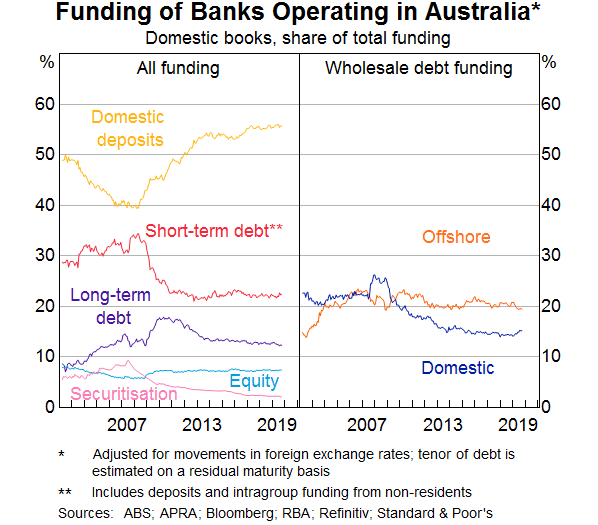
There are some modest but important differences between the funding of banks' domestic activity and their groups as a whole. Graph 2 captures a snapshot of the major banks' group-level funding composition by combining both their Australian-based operations and their overseas-based operations (both subsidiaries and branches). This broader coverage results in two interesting differences compared with the domestic-only focus (which is shown as dots in Graph 2, corresponding to the last observation in Graph 1):
- The share of deposit funding is somewhat lower, at just over 50 per cent of total group funding. This is unsurprising given that foreign branches tend to be restricted in their ability to accept deposits. The flip side of this is that the share of short-term and long-term debt is somewhat higher when considering the group as a whole.
- The major banks' share of offshore funding is higher when considering the group as a whole. Offshore funding is one-third of total operations (up from 20 per cent depicted in Graph 1).
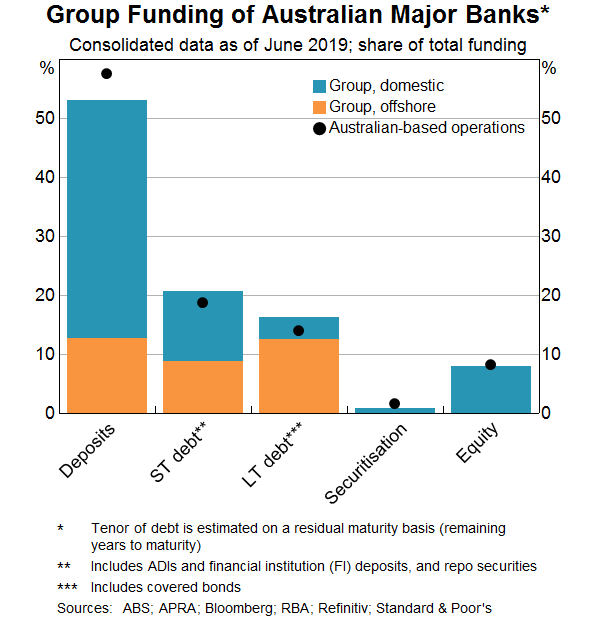
Further insights on the riskiness of banks' funding come from focusing on the 30 per cent of this group funding that is sourced from offshore investors (Graph 3). This funding is quite evenly split between deposits, short-term debt and long-term debt. However, most of the offshore deposits are raised by banks' foreign subsidiaries while almost all of the offshore debt is raised by either the Australian-based operations or banks' foreign branches.
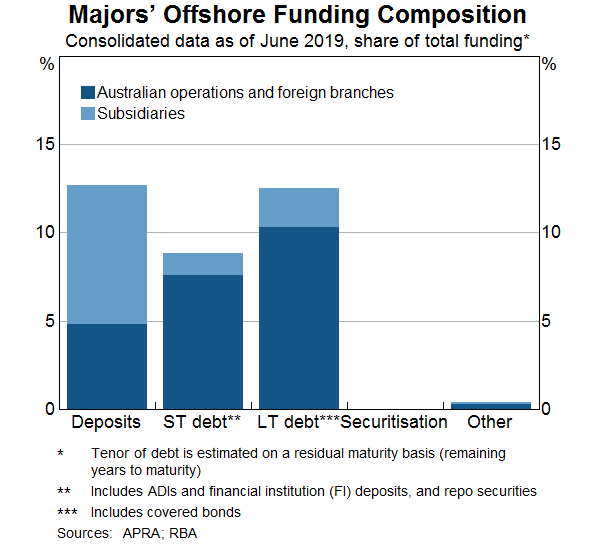
Offshore deposits
Deposits from offshore entities (excluding financial institutions) account for a bit over 10 per cent of total group funding of the major banks.[7] Around 60 per cent of this is sourced from banks' foreign subsidiaries through retail and small and medium enterprise (SME) customers (Graph 4). The remainder are placed by non-financial corporations (NFCs), mostly in the majors' Australian operations and foreign branches. (While we are unable to confidently break this down further, available data suggest that the split is approximately half and half between Australian-based operations and foreign branches). A sizeable portion of these NFC deposits are used for investment purposes, rather than to fund the NFC's regular operations, and are therefore prone to runs in periods of perceived or actual stress.[8] In that way, these offshore deposits may not be too different to offshore debt securities.
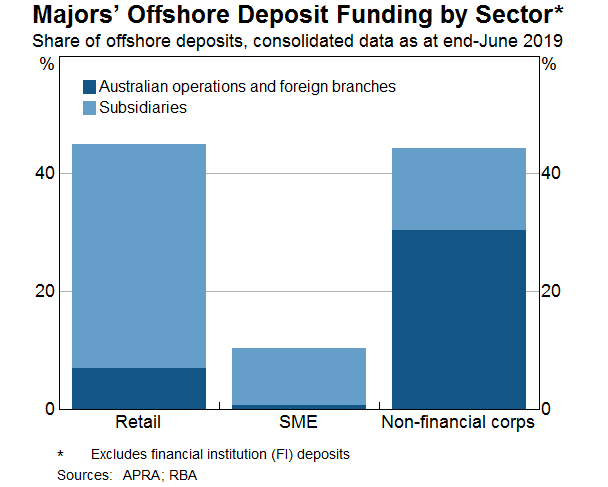
Banks' offshore deposits are sourced from a broad range of countries. Naturally, the largest share comes from banks' New Zealand subsidiaries (Graph 5). But banks also secure offshore deposits through their branches in a range of other countries. (Note that we cannot exclude deposits by financial institutions from the data by country, as done above.) Deposits by non-residents in the majors' Australian-based operations also come from counterparties that are resident in a wide range of countries. However, the bulk of these are from residents of the United States, various Asian countries and the United Kingdom. A large portion of deposits from non-resident financial institutions are denominated in US dollars, while other non-residents (especially households) are more inclined to hold Australian dollar-denominated deposits (Graph 6).
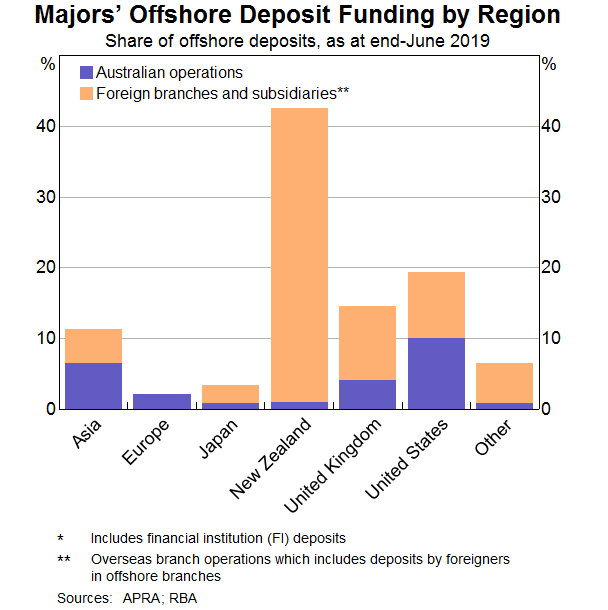
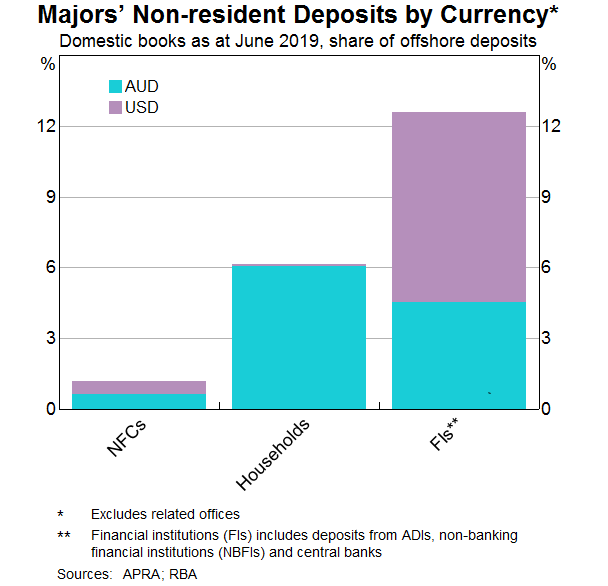
Offshore wholesale debt
Wholesale debt (both debt securities and wholesale deposits) issued overseas or held by foreigners account for around 20 per cent of total funding for major Australian banks.[9] Of this, almost 50 per cent is long-term debt (both unsecured and long-term covered bonds; Graph 7).
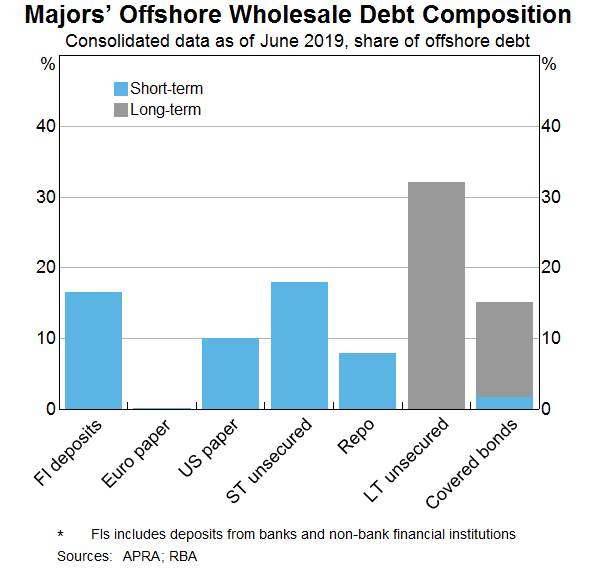
The majority of offshore debt securities are raised by the Australian-based operations and are used to fund domestic banking (Graph 8). However, around 20 per cent of total offshore debt securities are issued by the majors' foreign branches or their New Zealand subsidiaries. The United Kingdom and United States' markets are by far the main locations for the groups' debt security issuance. About half of this is denominated in US dollars (Graph 9).[10] A sizeable share is also issued in euros, primarily out of London and most likely to European-based investors.
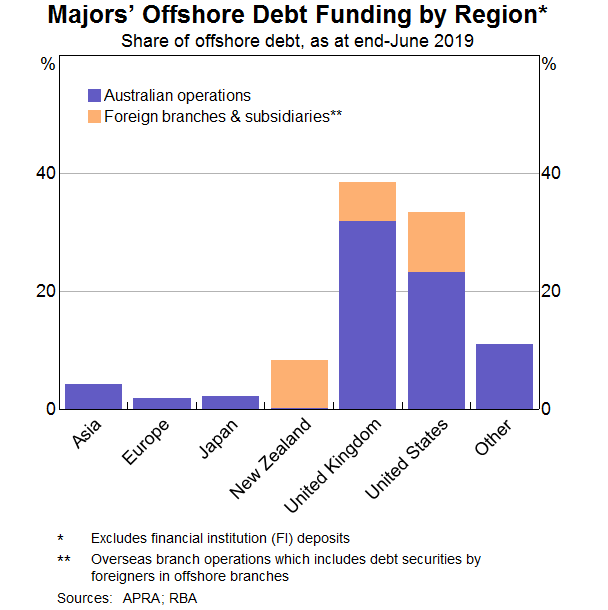
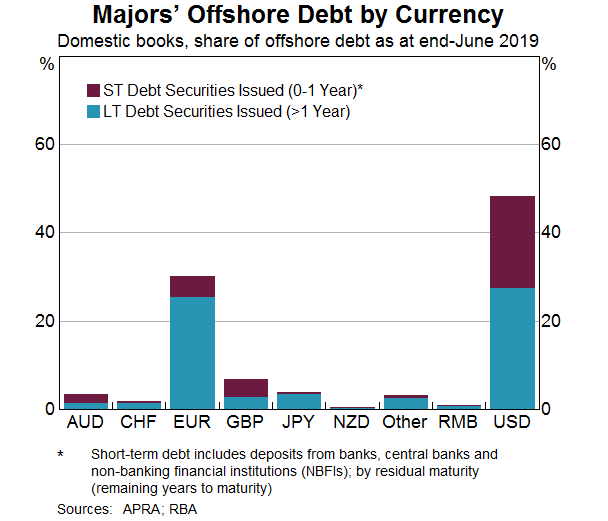
The remaining (‘residual’) maturity of banks' bonds is an important consideration for rollover risk, as it determines the amount of bond funding that must be refinanced each year to support a stable asset base. The average residual term to maturity for offshore bonds issued by Australian banks has risen in recent years, from 3.5 to 4.5 years (Graph 10). However, this is still well below the average residual maturity of bond issuance by most other developed countries' banks, with the exception of Canada and Sweden. This is despite US, European and UK banks raising a larger share of their debt from home country investors, meaning they face less risk from home bias than Australian banks.
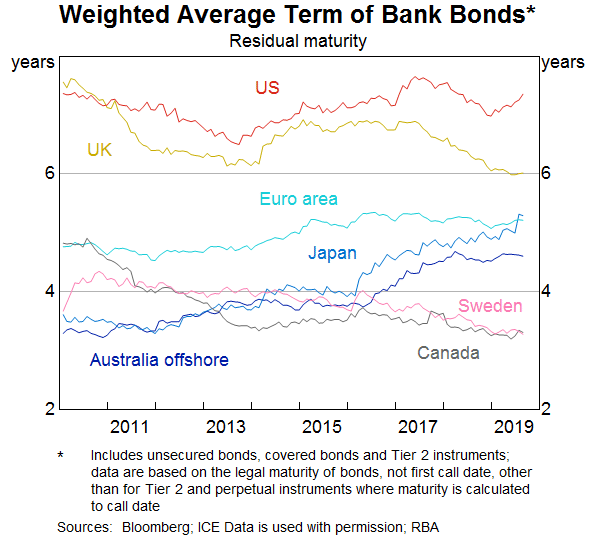
Australian banks find it difficult to obtain foreign exchange hedging contracts for tenors longer than 10 years, making it unattractive to issue such long-term bonds. However, this does not appear to be the reason why they have a shorter average residual maturity than banks in other countries. In particular, the share of Australian bank bonds issued offshore that have very long maturities (greater than 10 years) is very similar to that of other banks issuing in US dollars and euros (including by banks resident in the United States and Europe).[11] Rather, the reason Australian bank bonds have a shorter residual maturity than those of other banks issuing in the same market is that they have much fewer bonds with a medium term residual maturity (that is, 5–10 years; Graph 11).
While Australian banks' offshore bond maturities are shorter than those of many other developed economies' banks, they are longer than the maturities of their domestic issuance (Graph 12). In particular, outstanding domestically issued bonds very rarely have a residual maturity of more than five years. This illustrates that offshore funding can in fact provide benefits in reducing rollover risk.
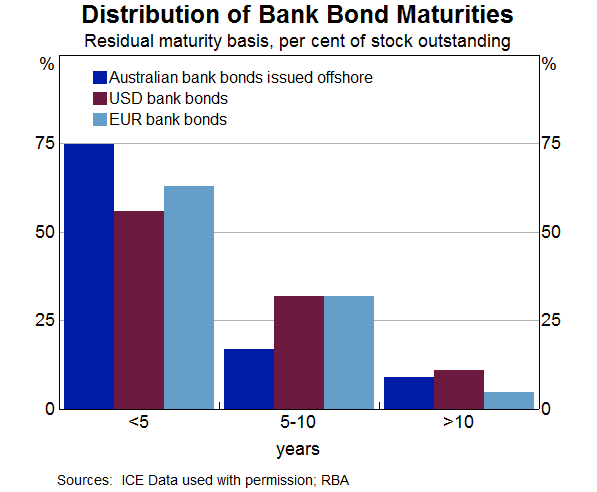
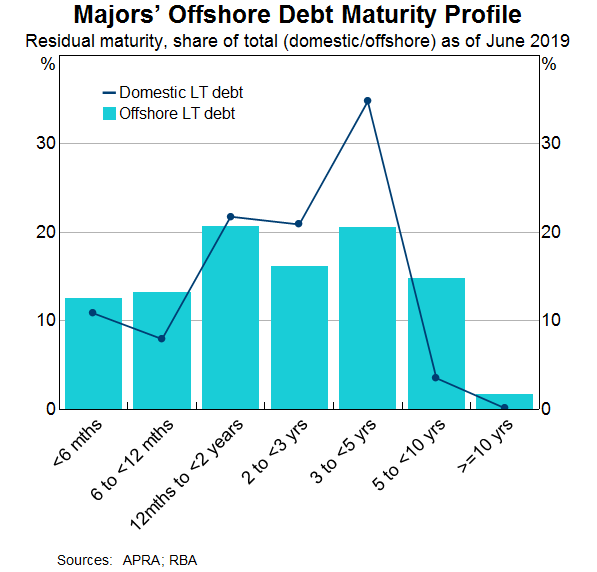
How Risky is Offshore Funding?
The degree of rollover risk for banks depends on both the characteristics of their funding and that of the assets this funding is used to acquire. In particular, banks can comfortably operate with more ‘flighty’ sources of funding if their assets are also of shorter duration or are more liquid. A bank operating in this way can then respond to difficulties rolling over maturing funding by selling liquid assets or refusing to rollover maturing assets. That latter response can have significant implications for Australian financial stability if those assets are facilitating domestic economic activity, but this is less likely to be problematic if those assets are located offshore. Given this, we next look at the type and maturity of the assets banks acquire with their offshore funding.
Offshore assets held by the Australian majors' account for around 25 per cent of their consolidated assets (Graph 13). Around 10 percentage points of this are loans written by banks' New Zealand subsidiaries, a further 5 percentage points is loans written by foreign branches and the rest is a combination of high quality liquid assets (HQLA) and repurchase agreements (repo) written by banks' foreign branches. The remaining gap between offshore funding and offshore assets implies that around one-quarter of offshore funding (almost 10 per cent of total group assets) is also used to write Australian-based assets.
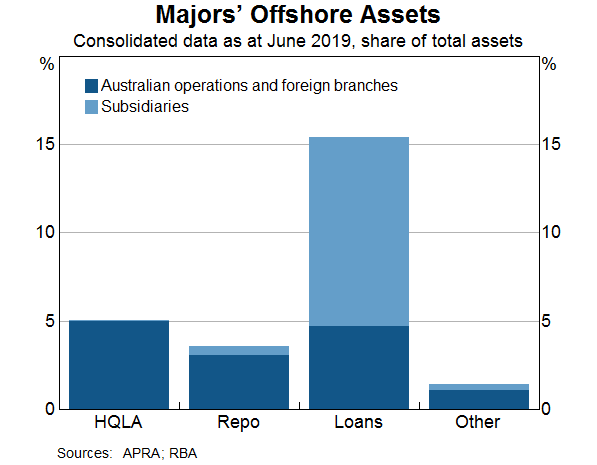
The maturity profile of these offshore assets can also be used to determine the extent of maturity mismatch banks face on their offshore funding. Banks relying on retail at-call deposits and with access to central bank liquidity support will naturally do more maturity transformation than other banks because the run-risk on retail deposits is much lower than on other forms of funding. For this reason, we confine our scope to exclude banks' offshore subsidiaries, who fund themselves mainly from retail deposits and have access to liquidity from the Reserve Bank of New Zealand.
Graph 14 shows that the major banks have about $95 billion more offshore liabilities than offshore assets maturing at a short time horizon (within the next 30 days). While this maturity mismatch is conventional for banking, ‘home bias’ risks inherent in offshore funding add an additional complexity to net funding pressures than if it was created by domestic retail deposits. However, a significant share of the resulting shortfall is covered by their offshore HQLA, which often has a long maturity but can typically be liquidated quickly with little discount. Banks have additional HQLA in Australia (amounting to $200 billion) that could also be used to meet an offshore funding shortfall, since a sizeable portion of this foreign funding is used to acquire Australian dollar assets. These holdings are an important mitigant of banks' vulnerability to liquidity risk on offshore funding.
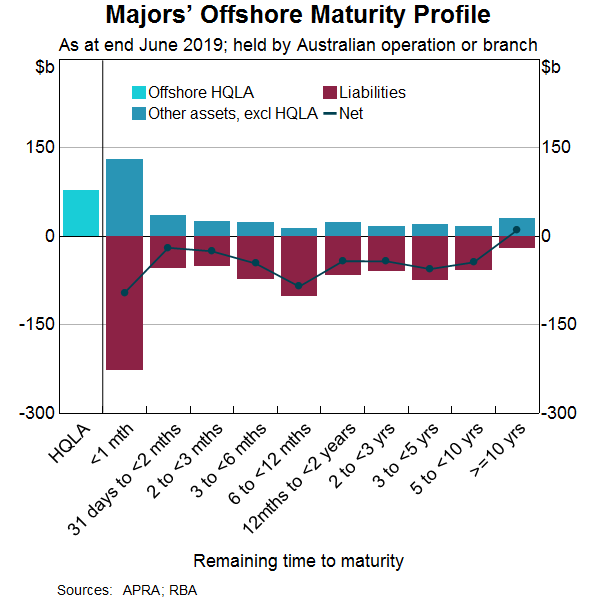
A few other factors also reduce the risks that Australian banks face because of their offshore funding. They include:
- Exchange rate hedging – Australian banks hedge their foreign-currency denominated funding back to Australian dollars when it is used to fund Australian dollar (AUD) assets.[12] These hedges also typically match the average duration of their funding. This hedging ensures that the net value of FX-denominated liabilities will not rise when the Australian dollar depreciates.
- Supportive margin calls – it is likely that any closure of foreign funding markets to Australian banks would be associated with a depreciation of the Australian dollar, given the importance of Australian banks for the country's international capital flows and the historically negative correlation of the AUD with risk appetite. An immediate implication of this is that derivative counterparties would need to post additional margin against their cross-currency swap positions with Australian banks. In liaison, banks note that the size of these margin calls could be enough to cover a significant share of the funding shortfall implied by Graph 14. A second implication is that banks' requirements for offshore funding would decline in foreign currency terms, to the extent that they are used to fund AUD-denominated assets. This would allow Australian banks to reduce their call on offshore funding without limiting their ability to write AUD-denominated loans.
-
Offshore borrowing funds domestic assets – Australian banks use a sizeable portion of their offshore funding to acquire AUD assets (along with liquid and short-term assets), not FX-denominated ones. This is a key distinction to how offshore funding was used by European banks that experienced severe funding difficulties at the onset of the financial crisis.
One reason why this matters is that, in the event of a retreat by foreign investors, a portion of the AUD that they were supplying to Australian banks is highly likely to still be transmitted to Australian banks via other means. In other words, even if a foreign entity was to pull assets out of Australia, the AUD is simply transferred from one party to another and thus still remains within the domestic banking system. For example, foreign investors wanting to shed their exposure to AUD by swapping these into other currencies might transact with Australian entities (such as superannuation firms) seeking to shed their exposure to foreign currency.[13] When these Australian entities then either place these funds on deposit or invest them locally with other entities that place the money on deposit, much of the initial AUD will still find its way to Australian banks as a deposit.[14] However, it is unlikely that all of these funds will be smoothly transmitted to Australian banks in another form during a time of stress; in particular, the price of that funding could be significantly higher.
- Liquidity assistance – as a last resort, the RBA can ultimately provide liquidity to Australian banks against eligible collateral. This is possible because Australian banks primarily require Australian dollar funding, not foreign-currency-denominated funding. Given their self-securitised loans, the major banks potentially have a large pool of eligible collateral to secure funding from the RBA, if the Bank is prepared to lend against it at the time.
Conclusion
Looking across the major Australian banks' worldwide operations, rather than just their Australian-based activities as has historically been done, we find that offshore funding accounts for around one-third of the major banks' total funding, evenly split between deposits, short-term and long-term debt. A significant portion of this is raised by their New Zealand subsidiaries, and does not pose the same rollover risk as other foreign funding. Of the remainder, some is raised by banks' Australian-based operations and some is raised by their foreign branches in a wide range of countries. This funding is often in US dollars (in many cases swapped back to Australian dollars), but sizeable amounts are also raised in euros and Australian dollars. The maturity of the majors' offshore bonds is longer than they can issue domestically, but still shorter than that of other banks issuing in the same markets.
Abstracting from their New Zealand activities, Australian banks largely use these offshore borrowings to fund short-term or liquid foreign assets, while repatriating a sizeable portion to fund Australian loans. In doing so, they face a rollover risk if foreigners refuse to renew this funding during periods of stress. However, a number of factors mitigate the risk that this vulnerability could create severe funding shortages for these banks.
Given these mitigating factors, the Council of Financial Regulators (CFR) recently concluded that it was not necessary to introduce measures to discourage Australian banks from using offshore funding. However, it agreed that a further lengthening of the maturity of their offshore borrowing would reduce the rollover risk for banks and the broader financial system.
Appendix – Data used in this article
Authorised deposit-taking institutions (ADI) in Australia are required to report data on their balance sheet and profitability to the Australian Prudential Regulation Authority (APRA). This information is collected under various reporting standards and is used by APRA for the purpose of prudential supervision and by the RBA for understanding financial conditions and systemic risk.
ADIs are required to provide APRA with information at three consolidation levels (Figure 1):
- Domestic books consolidation – this captures positions and transactions recorded on the Australian books of reporting entities. This includes Australian-owned and -based operations and Australian-based branches of foreign banks.
- Level 1 consolidation – this includes all Australian-owned and based operations, as well as overseas-based branches of Australian-owned ADIs. It does not include any information for foreign-owned banks operating in Australia.
- Level 2 or Group-level consolidation – this includes Level 1 consolidation, plus overseas-based offshore banking subsidiaries of the ADI. Unlike branches, subsidiaries operate as a separate legal entity that holds its own capital and are prudentially regulated in their host country.
Reporting forms used in this analysis
In the past, most analysis has utilised domestic books data, using ABS/RBA Statement of Financial Position forms (ARF_720.0A).
This article uses Group-level (Level 2) data obtained from the Contractual Maturity Mismatch - Funded Assets; Funding Liabilities & Capital forms (ARF 210.3.1; ARF 210.3.2). These datasets collect information on the contractual maturity profile of funded assets, funding liabilities and capital of an ADI. It is to be completed at a Level 1 and Level 2 basis for locally incorporated ADIs. (Foreign ADIs only report these data on a domestic books' basis.)
Information that identifies banks' offshore branches or subsidiaries separately from the domestic books are sourced from the International Operations forms (ARF 325.0).
To gain information about funding in different currencies, and the country split of debt securities issued by the domestic books of major banks, we use locational International Banking Statistics (IBS) data (ARF 731.1). IBS data are comprised of the international assets and liabilities of all banking offices located in Australia; that is, they are on a domestic books' basis. The locational data measure the international positions of Australian banks on an unconsolidated basis. This means they exclude the assets and liabilities of the foreign operations of Australian-owned banks but include cross-border positions between offices of the same banking group (intragroup positions).
Footnotes
The authors are from Financial Stability Department. [*]
Offshore funding includes money raised from non-residents and/or debt securities issued in a market other than the Australian domestic market. [1]
See Ellis (2016). [2]
For more information on how home bias can strengthen when financial conditions tighten, see Gianetti and Laeven (2012). [3]
The FSAP reports for Australia can be found at <https://www.imf.org/external/np/fsap/fsap.aspx>. [4]
Appendix A contains a more precise definition of these three different units of consolidation. [5]
Similar trends have been seen on a global scale. For more information, see CGFS (2018). [6]
Deposits from financial institutions are classified as short-term debt, since they behave similarly to debt and are treated as debt under regulation. [7]
Liquidity regulations treat operational deposits (those that customers use for transactional purposes) differently to other (non-operational) deposits. Non-operational deposits are considered to be more likely to run in stress conditions and, for NFC's, therefore attract a 100 per cent run-off rate. [8]
This figure understates foreign ownership of the major banks' debt securities, because it only captures bonds issued in a market other than Australia. ABS data show that a further $50 billion of bonds issued in Australia are owned by foreigners. (As a share of total consolidated funding, this equates to 1½ per cent.) [9]
This graph is on a domestic books basis due to data constraints. Given that a significant portion of offshore debt funding is from Australian-based operations, this is likely to be similar to the distribution on a group basis. [10]
It is not possible to get reliable data, across a wide range of countries, on the distribution of bank bond maturities by the nationality of issuing banks. However, we can access such data for Australian banks, and for the currencies in which global and Australian banks most commonly issue bonds (US dollars and euros). [11]
See Berger-Thomson and Chapman (2017). [12]
This trade might occur because of a ‘home bias’ on the part of Australian residents, or because an AUD depreciation leaves them over-allocated to foreign currency-denominated assets. Note that there could also be some steps in this process: for example, a (foreign) hedge fund could facilitate the initial exchange of FX to AUD. But as long as the hedge fund then invests those AUD it will still find its way to Australian residents. [13]
This argument is closely related to the ‘loans create deposits’ argument. See Kent (2018) and Doherty, Jackman and Perry (2018) for a fuller discussion. [14]
References
Berger-Thomson L and B Chapman (2017), ‘Foreign currency exposure and hedging in Australia’, RBA Bulletin, December, pp 67–75.
CGFS (2018), ‘Structural changes in banking after the crisis’, Report prepared by a Working Group established by the Committee on the Global Financial System, 24 January. Available at <https://www.bis.org/publ/cgfs60.htm>.
Doherty E, B Jackman and E Perry (2018), ‘Money in the Australian Economy’, RBA Bulletin, September, viewed 5 December. Available at < https://www.rba.gov.au/publications/bulletin/2018/sep/money-in-the-australian-economy.html>.
Ellis L (2016), ‘Financial Stability and the Banking Sector’, speech to the Sydney Banking and Financial Stability Conference, Sydney, 12 July.
Gianetti M and L Laeven (2012), ‘The flight home effect: Evidence from the syndicated loan market during financial crises’, Journal of Financial Economics, 104(1), pp 22–43.
Kent C (2018), ‘Money – Born of Credit?’, RBA's Topical Talks Event for Educators, Sydney, 19 September.